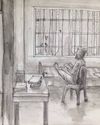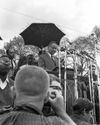
WHEN WE MEET MAALI ALMEIDA—an intrepid photojournalist and the protagonist of Shehan Karunatilaka’s Chats with the Dead, published earlier this year—he is recently dead. The novel is set in 1989, a time Karunatilaka chose because it was what he calls a “perfect storm of terrors.” The Liberation Tigers of Tamil Eelam, the Sri Lankan army, Indian peacekeepers, members of the Janatha Vimukthi Peramuna party and the state’s death squads were all locked in conflict on Sri Lankan soil, running an obstacle course filled with curfews, bombs, assassinations and abductions.
The story is told from Maali’s perspective, as he tries to navigate the convoluted landscape of the afterlife, and reconcile with his own death. He does not remember who his killer is—and so, in fact, has been effectively disappeared, both from the world and from himself. “The details come to you in itches and aches,” he muses. “In the Sri Lanka of the ’80s, ‘disappeared’ was a passive verb, something the government or JVP anarchists or Tiger separatists or Indian Peace Keepers could do to you depending on which province you were in and who you looked like.”
This story is from the November 2020 edition of The Caravan.
Start your 7-day Magzter GOLD free trial to access thousands of curated premium stories, and 8,500+ magazines and newspapers.
Already a subscriber ? Sign In
This story is from the November 2020 edition of The Caravan.
Start your 7-day Magzter GOLD free trial to access thousands of curated premium stories, and 8,500+ magazines and newspapers.
Already a subscriber? Sign In

Mob Mentality
How the Modi government fuels a dangerous vigilantism

RIP TIDES
Shahidul Alam’s exploration of Bangladeshi photography and activism

Trickle-down Effect
Nepal–India tensions have advanced from the diplomatic level to the public sphere

Editor's Pick
ON 23 SEPTEMBER 1950, the diplomat Ralph Bunche, seen here addressing the 1965 Selma to Montgomery March, was awarded the Nobel Peace Prize. The first black Nobel laureate, Bunche was awarded the prize for his efforts in ending the 1948 Arab–Israeli War.

Shades of The Grey
A Pune bakery rejects the rigid binaries of everyday life / Gender

Scorched Hearths
A photographer-nurse recalls the Delhi violence

Licence to Kill
A photojournalist’s account of documenting the Delhi violence

CRIME AND PREJUDICE
The BJP and Delhi Police’s hand in the Delhi violence

Bled Dry
How India exploits health workers

Status Update
India’s telling silence on the Hagia Sophia controversy